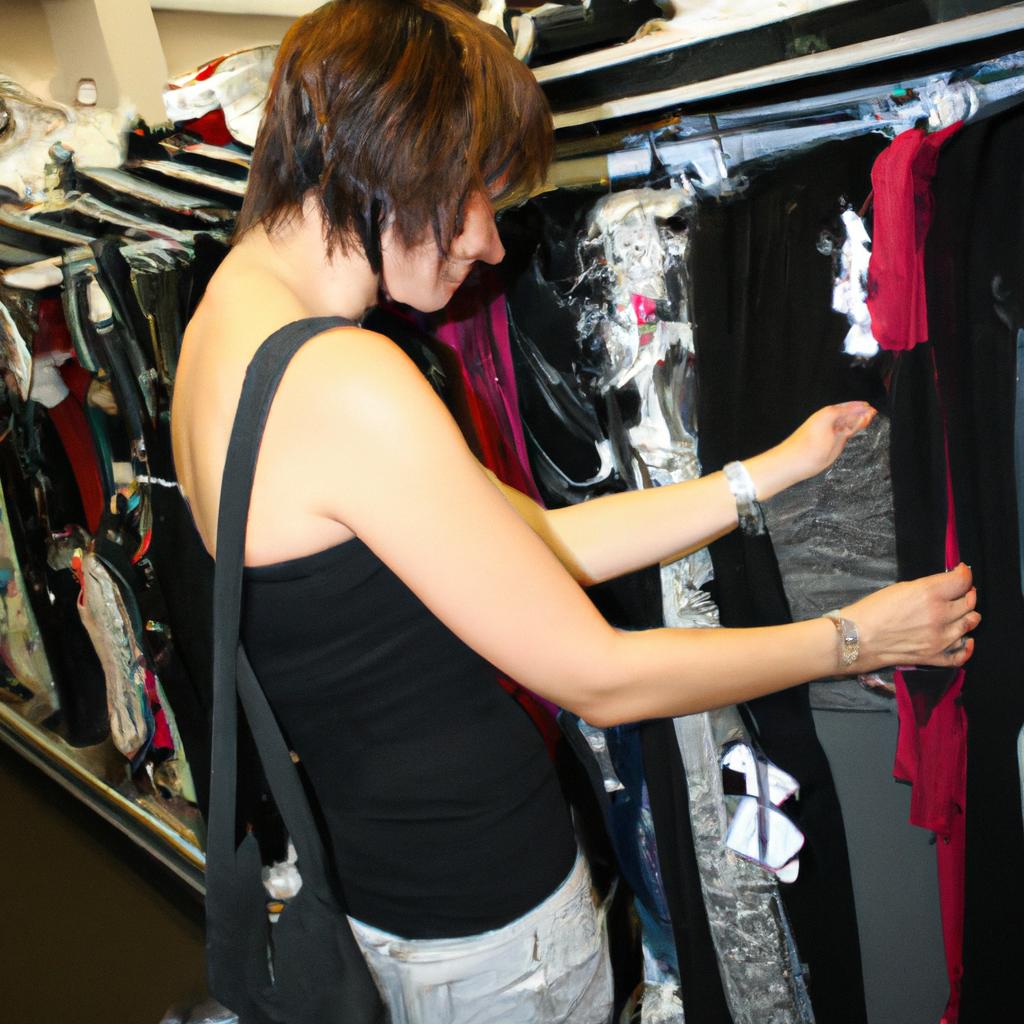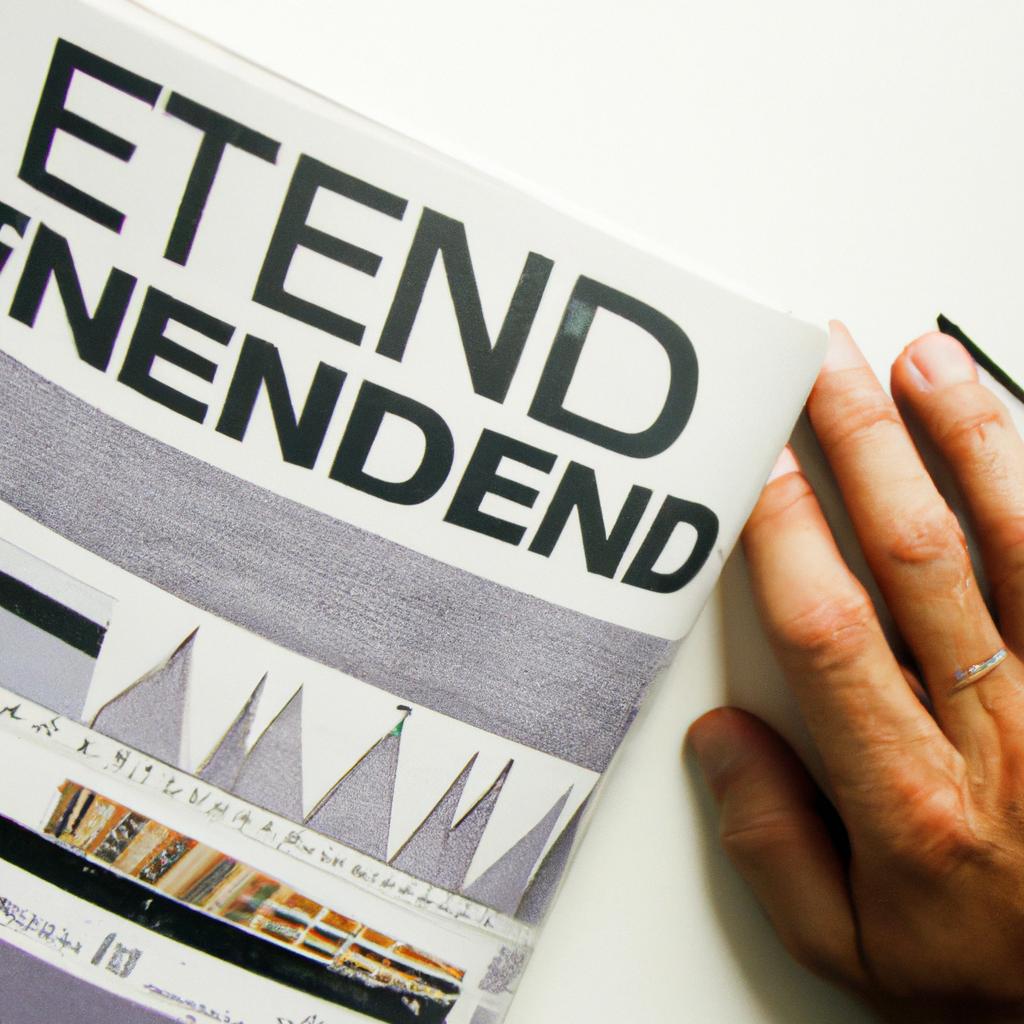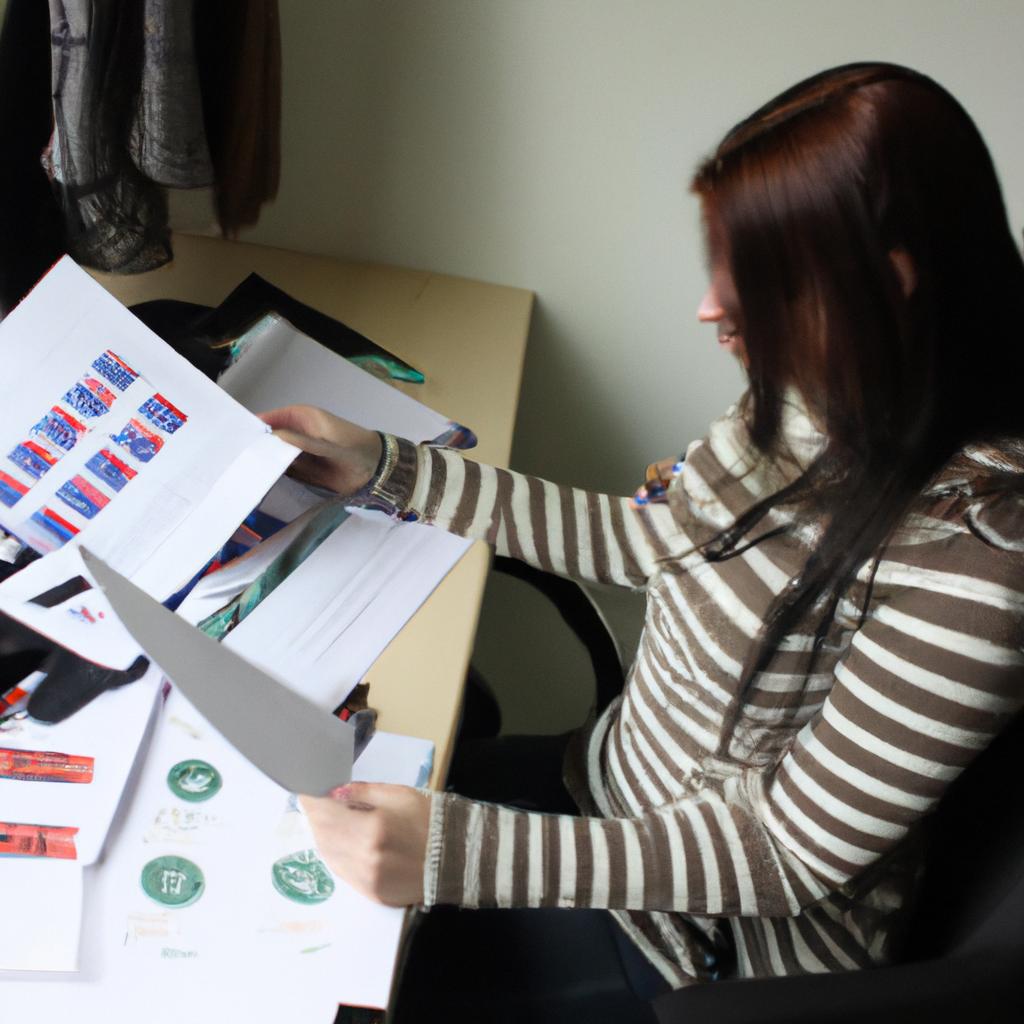Dressing for Success: Women’s Clothing in Fashion Finance

The importance of dressing for success in the world of finance cannot be underestimated. In this article, we will explore the significance of women’s clothing choices in the context of fashion finance. To illustrate this point, let us consider a hypothetical scenario: Jane is a young professional who has recently secured an interview at a prestigious financial firm. She possesses all the necessary qualifications and skills required for the position; however, her choice of attire could make or break her chances of securing the job. This example highlights how crucial it is for women to understand and navigate through the complexities of appropriate dress codes within the realm of finance.
In today’s competitive business environment, strategic dressing plays a vital role in establishing credibility and projecting professionalism. The field of finance demands individuals who exude confidence and competence not only through their expertise but also through their appearance. Women working in fashion finance face unique challenges when it comes to choosing suitable clothing that strikes a balance between conforming to corporate expectations while maintaining personal style. As such, understanding the nuances and unwritten rules governing appropriate attire becomes imperative for achieving success in this industry. By delving into various aspects such as dress codes, cultural influences, and gender biases, this article aims to provide insights on how women can effectively leverage their wardrobe choices to to make a positive impact in the world of fashion finance.
First and foremost, understanding dress codes within the financial industry is crucial. Different companies may have different expectations, ranging from business formal to business casual attire. Researching the company’s culture and observing what current employees wear can provide valuable insights. Women should aim to dress professionally, opting for well-tailored suits or dresses that convey a sense of professionalism and sophistication. Attention to detail, such as ensuring clothes are clean and ironed, can also make a significant difference in creating a polished image.
Cultural influences should also be considered when choosing appropriate attire in fashion finance. Globalization has led to increased diversity within workplaces, with individuals from various cultural backgrounds working together. It is essential for women to understand cultural norms regarding clothing choices, as what may be acceptable in one culture could be perceived differently in another. Being mindful of these differences demonstrates cultural competence and respect for colleagues’ values.
Unfortunately, gender biases still exist within many industries, including finance. It is essential for women to navigate these biases while maintaining their personal style and authenticity. Striking a balance between conforming to corporate expectations and expressing individuality can be challenging but not impossible. By incorporating subtle details such as statement accessories or pops of color into their outfits, women can showcase their unique style while still adhering to professional standards.
Overall, women’s clothing choices play a significant role in shaping perceptions within the world of fashion finance. By understanding dress codes, considering cultural influences, and navigating gender biases effectively, women can leverage their wardrobe choices to make a positive impact on their careers. Dressing for success not only helps establish credibility but also instills confidence and allows individuals to present themselves as capable professionals who are serious about their work. So whether it’s an interview or day-to-day interactions at work, making thoughtful clothing choices is an investment that can yield great returns in this competitive industry.
The Power of a Professional Image
Imagine walking into an important business meeting and noticing that one woman stands out from the rest. She exudes confidence, her attire meticulously put together with tailored clothing, polished shoes, and subtle accessories. Instantly, she commands attention and respect in the room. In today’s competitive world of finance, where first impressions matter greatly, projecting a professional image is crucial for success.
A professional appearance not only conveys competence but also influences how others perceive an individual’s credibility and trustworthiness. Dressing appropriately can be seen as a form of nonverbal communication that speaks volumes about a person’s professionalism and level of dedication to their work. Research has shown that individuals who dress professionally are more likely to be perceived as competent and capable by both clients and colleagues.
To further emphasize the importance of dressing for success in the financial industry, consider the following bullet points:
- A well-dressed professional creates a positive first impression.
- Proper attire enhances self-confidence and boosts morale.
- It helps establish authority and instill trust among clients.
- Dressing professionally shows respect for oneself, colleagues, and clients.
In addition to these compelling reasons, it is essential to understand specific guidelines regarding appropriate workplace attire in finance. The table below outlines some key elements:
| Attire | Suggested Clothing Items | Recommended Colors |
|---|---|---|
| Formal | Tailored suits | Navy or charcoal |
| Business | Blazer/jacket with trousers/skirt | Neutral tones |
| Smart Casual | Slacks/dress pants with blouse/top | Earthy colors |
By adhering to these guidelines, professionals working within the financial sector can ensure they present themselves appropriately while maintaining their personal style.
Understanding the Dress Code section delves deeper into different dress codes commonly observed in finance settings without restricting individual creativity or expression. By comprehending these expectations, individuals can strike a balance between professionalism and personal style that aligns with their career goals.
Understanding the Dress Code
In today’s fast-paced and competitive world, the significance of a professional image cannot be overstated. It is not just about how capable one is in their field; it also extends to how they present themselves visually. A prime example illustrating this point is Sarah Thompson, an up-and-coming investment banker who managed to secure multiple high-profile clients solely based on her polished appearance and confident demeanor.
To understand the power of a professional image, let us delve into its key components. Firstly, clothing choices play a crucial role in creating the desired impression. Women working in fashion finance need to strike a balance between showcasing their personal style while adhering to industry standards. This delicate dance allows them to express individuality without compromising professionalism.
Considering the impact of attire on perception, it becomes evident that certain factors should be taken into account when selecting appropriate outfits for the workplace:
- Fit: Well-tailored garments enhance body proportions and exude sophistication.
- Colors: Opt for neutral shades like black, navy blue, or gray for a timeless look that commands respect.
- Fabric quality: Investing in high-quality fabrics ensures durability and further enhances professionalism.
- Accessories: Thoughtfully chosen accessories can elevate an outfit and convey attention to detail.
Table: Impactful Clothing Choices for Fashion Finance Professionals
| Factors | Description | Example |
|---|---|---|
| Fit | Well-tailored garments enhance body proportions | Tailored blazer |
| Colors | Neutral shades like black, navy blue, or gray | Black pencil skirt |
| Fabrics | High-quality materials ensure durability | Silk blouse |
| Accessories | Thoughtfully chosen pieces add polish | Pearl earrings |
By carefully considering these aspects when dressing for success in fashion finance, women can project an air of confidence and competence that leaves a lasting impression on colleagues and clients alike. The power of a professional image lies not only in the initial impact it makes but also in its ability to convey an individual’s commitment to excellence throughout their career.
Transitioning seamlessly, let us now explore the key elements that make up a successful outfit and further contribute to building a strong professional presence.
Key Elements of a Successful Outfit
Understanding the Dress Code: Key Elements of a Successful Outfit
Transitioning from understanding the dress code, it is important to delve into the key elements that make up a successful outfit. By analyzing these essential components, we can gain insight into how women in fashion finance can effectively present themselves in a professional yet stylish manner. To illustrate this point, let’s consider an example of a hypothetical situation where a young woman named Sarah has just landed her dream job at a renowned financial firm. As she prepares for her first day at work, Sarah understands that her appearance will play a significant role in making a positive impression on her colleagues and clients.
When dressing for success in fashion finance, there are four crucial aspects to keep in mind:
-
Fit: The fit of clothing should be tailored to accentuate one’s figure without being overly revealing or restrictive. Ill-fitting garments can give off an unprofessional vibe and detract from overall confidence.
-
Quality: Investing in high-quality pieces demonstrates attention to detail and professionalism. Opting for well-made fabrics and construction ensures longevity and portrays an image of reliability.
-
Balance: Achieving balance through proportions is essential when putting together an outfit. Pairing fitted tops with wide-legged trousers or structured blazers with flowing skirts creates harmony while allowing each element to shine.
-
Accessories: Thoughtfully chosen accessories add polish and personality to any ensemble. Simple yet elegant jewelry pieces, such as delicate necklaces or statement earrings, can elevate an outfit without overpowering it.
To further understand the significance of these key elements, let us examine their impact using a table:
| Element | Importance | Effect |
|---|---|---|
| Fit | Accentuates figure | Boosts self-confidence |
| Quality | Reflects professionalism | Enhances credibility |
| Balance | Creates visual harmony | Conveys attention to detail |
| Accessories | Adds polish and personality | Elevates overall appearance |
By adhering to these key elements, women in fashion finance can establish a strong professional identity while maintaining their own personal style. Dressing for success not only helps create an initial positive impression but also fosters confidence and credibility throughout one’s career.
Understanding the importance of each element in dressing for success paves the way for selecting the right colors that complement both skin tone and workplace culture.
Choosing the Right Colors
Transitioning from the previous section on the key elements of a successful outfit, let’s now delve into the importance of choosing the right colors when dressing for success in fashion finance. To illustrate this, consider a hypothetical scenario where two women are attending an investment conference. Woman A confidently struts in wearing a navy blue power suit that exudes professionalism and authority, while Woman B timidly enters the room clad in a pastel pink dress that may be perceived as less serious and competent. This example highlights how color choices can significantly impact one’s perception in a professional setting.
When it comes to selecting colors for your wardrobe in fashion finance, there are certain factors to consider. First and foremost is understanding the psychology behind different hues. Colors have inherent meanings and associations that evoke emotional responses within individuals. For instance:
- Darker shades like black, navy blue, or charcoal gray convey authority, seriousness, and trustworthiness.
- Bright colors such as red or yellow can symbolize confidence and optimism but should be used sparingly so as not to appear overly dominant.
- Neutral tones like beige or cream exude elegance and sophistication without overpowering one’s presence.
It is essential to strike a balance between showcasing personal style preferences while adhering to industry norms. In order to achieve this harmony, here is a list of practical tips to help you make informed decisions when choosing colors for your outfits:
-
Understand your audience: Consider who you will be interacting with and adapt your color choices accordingly. Different industries might have varying expectations regarding appropriate attire.
-
Dress appropriately for the occasion: Formal events often call for more conservative color palettes such as blacks, grays, or blues, whereas creative environments may allow for bolder choices.
-
Use complementary colors: Experiment with combining different hues strategically by using complementary pairs (colors opposite each other on the color wheel) to create visually appealing ensembles.
-
Consider cultural connotations: Be mindful of the cultural implications associated with certain colors, as they can vary across different regions and countries.
| Color | Meaning/Association | Appropriate Occasions |
|---|---|---|
| Navy Blue | Professionalism | Business meetings |
| Red | Confidence | Negotiations |
| Gray | Reliability | Presentations |
| White | Purity | Client consultations |
As we conclude this section on choosing the right colors for dressing success in fashion finance, it is evident that selecting appropriate hues can greatly impact one’s professional image. Understanding the psychology behind various shades and considering factors such as audience, occasion, complementary combinations, and cultural connotations will help you make informed decisions when curating your wardrobe. In our subsequent section on “Dressing for Different Occasions,” we will explore how to adapt your attire based on specific situations without compromising style or professionalism.
Dressing for Different Occasions
Building on the importance of choosing the right colors, we will now explore how to dress appropriately for different occasions in the world of finance. Being mindful of the context and environment is essential when it comes to making a positive impression with your attire. Let’s consider an example where a young professional, Lisa, needs to navigate various events during her first week at a prestigious financial firm.
Paragraph 1:
During her orientation session, Lisa quickly noticed that each day brought forth a unique set of expectations regarding appropriate attire. For formal board meetings or client presentations, she learned that a tailored suit in classic hues such as navy blue or charcoal grey was always a safe bet. On the other hand, company-wide team-building activities called for business casual outfits – stylish yet comfortable ensembles that still maintained professionalism. By adapting her wardrobe choices according to these diverse scenarios, Lisa successfully conveyed her ability to effortlessly transition between different levels of formality within the workplace.
Paragraph 2:
To further understand how clothing can impact one’s perception in various settings, let us examine four key factors to consider when dressing for different occasions:
- The nature of the event: Whether attending industry conferences or social gatherings with colleagues after work hours, understanding the purpose and expected ambiance of an occasion helps guide appropriate outfit selections.
- Cultural norms: Recognizing and respecting cultural differences ensures that you make a positive impression while navigating international business environments.
- Time of day: Adjusting your attire based on whether an event calls for morning seminars or evening cocktail receptions showcases your attention to detail and adaptability.
- Company culture: Observing what senior executives or successful professionals wear within your organization provides valuable insights into acceptable dress codes.
These considerations create awareness about not only personal style but also demonstrate sensitivity towards others’ preferences and societal norms which contributes significantly to building strong relationships within any professional setting.
Paragraph 3:
In conclusion, dressing for different occasions in the finance industry requires adaptability and a keen eye for appropriate attire. By understanding the expectations of each event, considering cultural norms, being mindful of timing, and aligning with company culture, professionals can effectively communicate their professionalism and respect for others. In our next section on “Accessorizing for Success,” we will explore how to enhance your outfits with carefully chosen accessories that complement your overall look without overpowering it.
As you continue refining your professional wardrobe choices, let’s now delve into the art of accessorizing in order to complete your polished appearance.
Accessorizing for Success
Transitioning from the previous section discussing appropriate attire for different occasions, we now turn our attention to the importance of accessorizing in achieving a successful and polished appearance in fashion finance. As professionals in this industry understand, the right accessories can elevate an outfit, making it both stylish and suitable for the workplace. To illustrate this point, let us consider the hypothetical case of Sarah—a rising star in the world of fashion finance—who effortlessly transforms her look by incorporating strategic accessories into her daily ensembles.
One key aspect of effective accessorizing is understanding how to choose pieces that complement one’s personal style while adhering to professional standards. The following bullet points outline some essential considerations when selecting accessories for women working in fashion finance:
- Quality: Opt for high-quality accessories made from durable materials as they not only convey professionalism but also ensure longevity.
- Versatility: Choose versatile accessories that can be easily styled with multiple outfits, allowing you to create various looks without investing heavily in new items.
- Balance: Maintain a balance between statement and subtle pieces; too many bold accessories may distract from your overall image, while too few might appear underwhelming.
- Brand awareness: Consider supporting ethical brands aligned with sustainable practices or those known for their contribution to social causes within the fashion industry.
To further emphasize the significance of accessorizing effectively, let us explore a table showcasing three common accessory categories—jewelry, handbags, and shoes—and their respective impact on enhancing a woman’s professional appearance:
| Accessory Category | Impact on Professional Appearance |
|---|---|
| Jewelry | Adds sophistication and elegance |
| Handbags | Enhances organization and poise |
| Shoes | Conveys confidence and authority |
By thoughtfully selecting accessories based on these categories’ characteristics, women in fashion finance have the opportunity to project an aura of competence and expertise while expressing their individuality.
In summary, mastering the art of accessorizing is vital for women working in the fashion finance industry. Carefully chosen accessories can transform an outfit, elevating its professional appeal and reflecting one’s personal style. By adhering to key considerations such as quality, versatility, balance, and brand awareness when selecting accessories, professionals can curate a polished look that exudes confidence and competence. Remember, achieving sartorial success goes beyond choosing the right clothing; it also involves skillful accessorizing that complements your overall image in the workplace.






